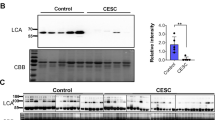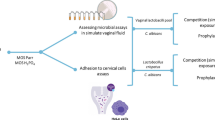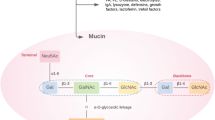Abstract
Cervical mucins are glycosylated proteins that form a protective cervical mucus. To understand the role of mucin glycans in Candida albicans infection, oligosaccharides from mouse cervical mucins were analyzed by liquid chromatography-mass spectrometry. Cervical mucins carry multiple α(1-2)fucosylated glycans, but α(1,2)fucosyltransferase Fut2-null mice are devoid of these epitopes. Epithelial cells in vaginal lavages from Fut2-null mice lacked Ulex europaeus agglutinin-1 (UEA-I) staining for α(1-2)fucosylated glycans. Hysterectomy to remove cervical mucus eliminated UEA-I and acid mucin staining in vaginal epithelial cells from wild type mice indicating the cervix as the source of UEA-I positive epithelial cells. To assess binding of α(1-2) fucosylated glycans on C. albicans infection, an in vitro adhesion assay was performed with vaginal epithelial cells from wild type and Fut2-null mice. Vaginal epithelial cells from Fut2-null mice were found to bind increased numbers of C. albicans compared to vaginal epithelial cells obtained from wild type mice. Hysterectomy lessened the difference between Fut2-null and wild type mice in binding of C. ablicans in vitro and susceptibility to experimental C. albicans vaginitis in vivo. We generated a recombinant fucosylated MUC1 glycanpolymer to test whether the relative protection of wild type mice compared to Fut2-null mice could be mimicked with exogenous mucin. While a small portion of the recombinant MUC1 epitopes displayed α(1-2)fucosylated glycans, the predominant epitopes were sialylated due to endogenous sialyltransferases in the cultured cells. Intravaginal instillation of recombinant MUC1 glycanpolymer partially reduced experimental yeast vaginitis suggesting that a large glycanpolymer, with different glycan epitopes, may affect fungal burden.




Similar content being viewed by others
Abbreviations
- CFU:
-
Colony forming unit
- Fut2:
-
a(1,2)fucosyltransferase “Secretor” gene
- UEA-I:
-
Ulex europaeus agglutinin I
References
Kelly, R.J., Rouquier, S., Giorgi, D., Lennon, G.G., Lowe, J.B.: Sequence and expression of a candidate for the human Secretor blood group alpha(1,2)fucosyltransferase gene (FUT2). Homozygosity for an enzyme-inactivating nonsense mutation commonly correlates with the non-secretor phenotype. J. Biol. Chem. 270, 4640–4649 (1995). doi:10.1074/jbc.270.9.4640
Chaim, W., Foxman, B., Sobel, J.D.: Association of recurrent vaginal candidiasis and secretory ABO and Lewis phenotype. J. Infect. Dis. 176, 828–830 (1997). doi:10.1086/517314
Kulkarni, D.G., Venkatesh, D.: Non-secretor status; a predisposing factor for vaginal candidiasis. Indian J. Physiol. Pharmacol. 48, 225–229 (2004)
Sobel, J.D., Wiesenfeld, H.C., Martens, M., Danna, P., Hooton, T.M., Rompalo, A., Sperling, M., Livengood 3rd, C., Horowitz, B., Von Thron, J., Edwards, L., Panzer, H., Chu, T.C.: Maintenance fluconazole therapy for recurrent vulvovaginal candidiasis. N. Engl. J. Med. 351, 876–883 (2004). doi:10.1056/NEJMoa033114
Fidel Jr, P.L.: Immunity to Candida. Oral Dis. 8(Suppl 2), 69–75 (2002). doi:10.1034/j.1601-0825.2002.00015.x
Nawrot, U., Grzybek-Hryncewicz, K., Zielska, U., Czarny, A., Podwinska, J.: The study of cell-mediated immune response in recurrent vulvovaginal candidiasis. FEMS Immunol. Med. Microbiol. 29, 89–94 (2000). doi:10.1111/j.1574-695X.2000.tb01509.x
Wormley Jr, F.L., Cutright, J., Fidel Jr, P.L.: Multiple experimental designs to evaluate the role of T-cell-mediated immunity against experimental vaginal Candida albicans infection. Med. Mycol. 41, 401–409 (2003). doi:10.1080/3693780310001597683
Fidel Jr, P.L.: History and update on host defense against vaginal candidiasis. Am. J. Reprod. Immunol. 57, 2–12 (2007). doi:10.1111/j.1600-0897.2006.00450.x
Barousse, M.M., Steele, C., Dunlap, K., Espinosa, T., Boikov, D., Sobel, J.D., Fidel Jr, P.L.: Growth inhibition of Candida albicans by human vaginal epithelial cells. J. Infect. Dis. 184, 1489–1493 (2001). doi:10.1086/324532
Steele, C., Leigh, J., Swoboda, R., Ozenci, H., Fidel Jr, P.L.: Potential role for a carbohydrate moiety in anti-Candida activity of human oral epithelial cells. Infect. Immun. 69, 7091–7099 (2001). doi:10.1128/IAI.69.11.7091-7099.2001
Barousse, M.M., Espinosa, T., Dunlap, K., Fidel Jr, P.L.: Vaginal epithelial cell anti-Candida albicans activity is associated with protection against symptomatic vaginal candidiasis. Infect. Immun. 73, 7765–7767 (2005). doi:10.1128/IAI.73.11.7765-7767.2005
Yano, J., Lilly, E.A., Steele, C., Fortenberry, D., Fidel Jr, P.L.: Oral and vaginal epithelial cell anti-Candida activity is acid labile and does not require live epithelial cells. Oral Microbiol. Immunol. 20, 199–205 (2005)
Vardar-Unlu, G., McSharry, C., Douglas, L.J.: Fucose-specific adhesins on germ tubes of Candida albicans. FEMS Immunol. Med. Microbiol. 20, 55–67 (1998). doi:10.1016/S0928-8244(97)00107-7
Brassart, D., Woltz, A., Golliard, M., Neeser, J.R.: In vitro inhibition of adhesion of Candida albicans clinical isolates to human buccal epithelial cells by Fuc alpha 1–2Gal beta-bearing complex carbohydrates. Infect. Immun. 59, 1605–1613 (1991)
Cameron, B.J., Douglas, L.J.: Blood group glycolipids as epithelial cell receptors for Candida albicans. Infect. Immun. 64, 891–896 (1996)
Hurd, E.A., Domino, S.E.: Increased susceptibility of secretor factor gene Fut2-null mice to experimental vaginal candidiasis. Infect. Immun. 72, 4279–4281 (2004). doi:10.1128/IAI.72.7.4279-4281.2004
Domino, S.E., Hurd, E.A.: LacZ expression in Fut2-LacZ reporter mice reveals estrogen-regulated endocervical glandular expression during estrous cycle, hormone replacement, and pregnancy. Glycobiology 14, 169–175 (2004). doi:10.1093/glycob/cwh019
Domino, S.E., Zhang, L., Gillespie, P.J., Saunders, T.L., Lowe, J.B.: Deficiency of reproductive tract alpha(1, 2) fucosylated glycans and normal fertility in mice with targeted deletions of the FUT1 or FUT2 alpha(1, 2) fucosyltransferase locus. Mol. Cell. Biol. 21, 8336–8345 (2001). doi:10.1128/MCB.21.24.8336-8345.2001
Schulz, B.L., Packer, N.H., Karlsson, N.G.: Small-scale analysis of O-linked oligosaccharides from glycoproteins and mucins separated by gel electrophoresis. Anal. Chem. 74, 6088–6097 (2002). doi:10.1021/ac025890a
Zhao, X., Oh, S.H., Cheng, G., Green, C.B., Nuessen, J.A., Yeater, K., Leng, R.P., Brown, A.J., Hoyer, L.L.: ALS3 and ALS8 represent a single locus that encodes a Candida albicans adhesin; functional comparisons between Als3p and Als1p. Microbiology 150, 2415–2428 (2004). doi:10.1099/mic.0.26943-0
Casanova, M., Cervera, A.M., Gozalbo, D., Martinez, J.P.: Hemin induces germ tube formation in Candida albicans. Infect. Immun. 65, 4360–4364 (1997)
Backstrom, M., Link, T., Olson, F.J., Karlsson, H., Graham, R., Picco, G., Burchell, J., Taylor-Papadimitriou, J., Noll, T., Hansson, G.C.: Recombinant MUC1 mucin with a breast cancer-like O-glycosylation produced in large amounts in Chinese-hamster ovary cells. Biochem. J. 376, 677–686 (2003). doi:10.1042/BJ20031130
Andersch-Bjorkman, Y., Thomsson, K.A., Holmen Larsson, J.M., Ekerhovd, E., Hansson, G.C.: Large scale identification of proteins, mucins, and their O-glycosylation in the endocervical mucus during the menstrual cycle. Mol. Cell. Proteomics 6, 708–716 (2007). doi:10.1074/mcp.M600439-MCP200
Thomsson, K.A., Schulz, B.L., Packer, N.H., Karlsson, N.G.: MUC5B glycosylation in human saliva reflects blood group and secretor status. Glycobiology 15, 791–804 (2005). doi:10.1093/glycob/cwi059
Domino, S.E., Zhang, L., Lowe, J.B.: Molecular cloning, genomic mapping, and expression of two secretor blood group alpha (1, 2) fucosyltransferase genes differentially regulated in mouse uterine epithelium and gastrointestinal tract. J. Biol. Chem. 276, 23748–23756 (2001). doi:10.1074/jbc.M100735200
Fidel Jr, P.L., Sobel, J.D.: Immunopathogenesis of recurrent vulvovaginal candidiasis. Clin. Microbiol. Rev. 9, 335–348 (1996)
Fidel Jr, P.L., Cutright, J., Steele, C.: Effects of reproductive hormones on experimental vaginal candidiasis. Infect. Immun. 68, 651–657 (2000). doi:10.1128/IAI.68.2.651-657.2000
Parr, M.B., Parr, E.L.: Mucosal immunity in the female and male reproductive tracts. In: Ogra, P.L., Mestecky, J.J., Lamm, M.E. (eds.) Handbook of mucosal immunity, pp. 677–689. Academic, San Diego (1994)
Zhang, X., Essmann, M., Burt, E.T., Larsen, B.: Estrogen effects on Candida albicans: a potential virulence-regulating mechanism. J. Infect. Dis. 181, 1441–1446 (2000). doi:10.1086/315406
Schaeffer, A.J., Navas, E.L., Venegas, M.F., Anderson, B.E., Kanerva, C., Chmiel, J.S., Duncan, J.L.: Variation of blood group antigen expression on vaginal cells and mucus in secretor and nonsecretor women. J. Urol. 152, 859–864 (1994)
Gipson, I.K.: Mucins of the human endocervix. Front. Biosci. 6, D1245–D1255 (2001). doi:10.2741/Gipson
Hein, M., Valore, E.V., Helmig, R.B., Uldbjerg, N., Ganz, T.: Antimicrobial factors in the cervical mucus plug. Am. J. Obstet. Gynecol. 187, 137–144 (2002). doi:10.1067/mob.2002.123034
Nardelli-Haefliger, D., Wirthner, D., Schiller, J.T., Lowy, D.R., Hildesheim, A., Ponci, F., De Grandi, P.: Specific antibody levels at the cervix during the menstrual cycle of women vaccinated with human papillomavirus 16 virus-like particles. J. Natl. Cancer Inst. 95, 1128–1137 (2003)
Nowicki, S., Tassell, A.H., Nowicki, B.: Susceptibility to gonococcal infection during the menstrual cycle. JAMA 283, 1291–1292 (2000). doi:10.1001/jama.283.10.1291
Sobel, J.D.: Pathogenesis and treatment of recurrent vulvovaginal candidiasis. Clin. Infect. Dis. 14(Suppl 1), S148–S153 (1992)
Ventolini, G., Baggish, M.S.: Post-menopausal recurrent vaginal candidiasis: effect of hysterectomy on response to treatment, type of colonization and recurrence rates post-treatment. Maturitas 51, 294–298 (2005). doi:10.1016/j.maturitas.2004.08.012
Murta, E.F., Filho, A.C., Barcelos, A.C.: Relation between vaginal and endocervical pH in pre- and post-menopausal women. Arch. Gynecol. Obstet. 272, 211–213 (2005). doi:10.1007/s00404-005-0740-4
Murta, E.F., Silva, A.O., Silva, E.A., Adad, S.J.: Frequency of infectious agents for vaginitis in non- and hysterectomized women. Arch. Gynecol. Obstet. 273, 152–156 (2005). doi:10.1007/s00404-005-0023-0
Thomsson, K.A., Hinojosa-Kurtzberg, M., Axelsson, K.A., Domino, S.E., Lowe, J.B., Gendler, S.J., Hansson, G.C.: Intestinal mucins from cystic fibrosis mice show increased fucosylation due to an induced Fucalpha1–2 glycosyltransferase. Biochem. J. 367, 609–616 (2002). doi:10.1042/BJ20020371
Olson, F.J., Backstrom, M., Karlsson, H., Burchell, J., Hansson, G.C.: A MUC1 tandem repeat reporter protein produced in CHO-K1 cells has sialylated core 1 O-glycans and becomes more densely glycosylated if coexpressed with polypeptide-GalNAc-T4 transferase. Glycobiology 15, 177–191 (2005). doi:10.1093/glycob/cwh158
Acknowledgments
We thank Paul Fidel for the gift of C. albicans strain 3153A, the personnel of the Cancer Center Research Histology and Immunoperoxidase Core at the University of Michigan for histological processing, Janet Hoff at the Center for Integrative Genomics at the University of Michigan for performing abdominal oophorectomy, Brady West at the Centre for Statistical Consultation and Research of the University of Michigan, the Mammalian Protein Expression Core Facility, and Dr. Hasse Karlsson for assistance with the LC-MS analysis and spectra deduction. This work was supported by grants from the University of Michigan Biomedical Research Council and Horace H. Rackham School of Graduate Studies, the Swedish Research Council (equipment and grant no. 7461), and the IngaBritt and Arne Lundberg Foundation.
Author information
Authors and Affiliations
Corresponding author
Additional information
Domino and Hurd contributed equally to this study.
Electronic Supplementary Material
Below is the link to the electronic supplementary material.
Supplemental Fig. 1
Vaginal epithelial cells obtained by vaginal lavage from wild type and Fut2-null mice stained with UEA-I and Alcian blue pH 2.5 with control panels shown. Wild type and Fut2-null mice underwent either control surgery (ovariectomy alone) or hysterectomy (ovariectomy and total hysterectomy) to remove the entire cervix along with uterus. Intense Alcian blue pH 2.5 mucin staining (top panel) was present in washings from ovariectomized control wild-type (A) and Fut2-null mice (C) but absent in washings from hysterectomized wild type (B) and Fut2-null mice (D). Duplicate slides stained with UEA-I (bottom panel) show specific brown lectin staining associated with vaginal epithelial cells from pseudoestrus ovariectomized wild type mice (E) but absent in washings from pseudoestrus ovariectomized Fut2-null (G), hysterectomized wild type (F) and Fut2-null (H) mice. Bar = 100 μm. (PDF 35.1 kb)
Rights and permissions
About this article
Cite this article
Domino, S.E., Hurd, E.A., Thomsson, K.A. et al. Cervical mucins carry α(1,2)fucosylated glycans that partly protect from experimental vaginal candidiasis. Glycoconj J 26, 1125–1134 (2009). https://doi.org/10.1007/s10719-009-9234-0
Received:
Revised:
Accepted:
Published:
Issue Date:
DOI: https://doi.org/10.1007/s10719-009-9234-0




